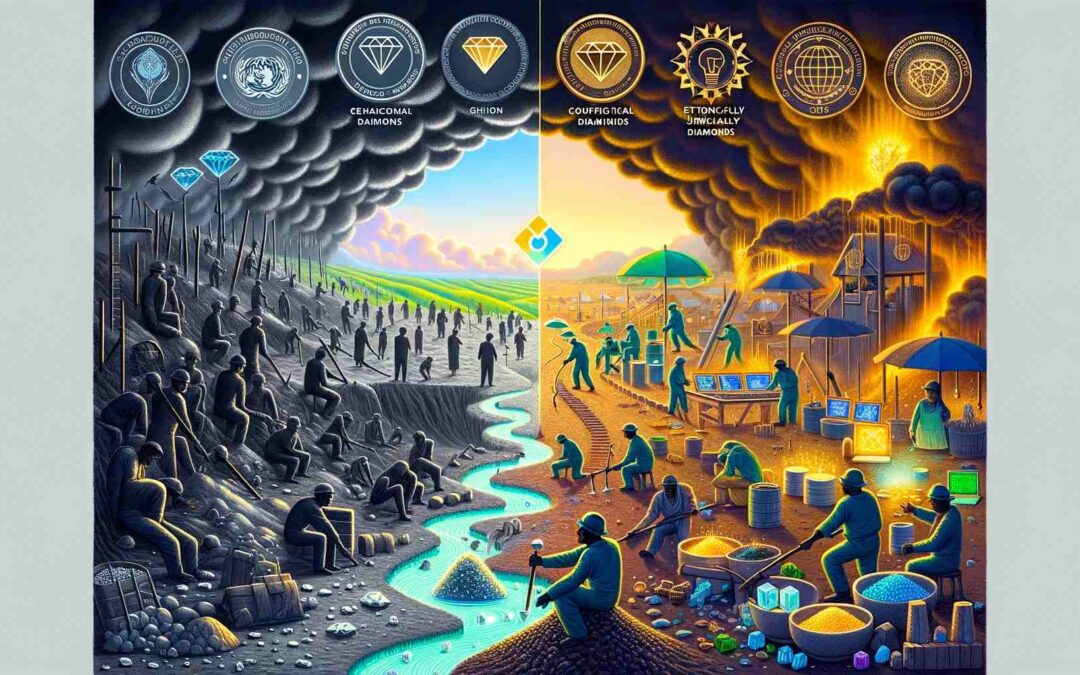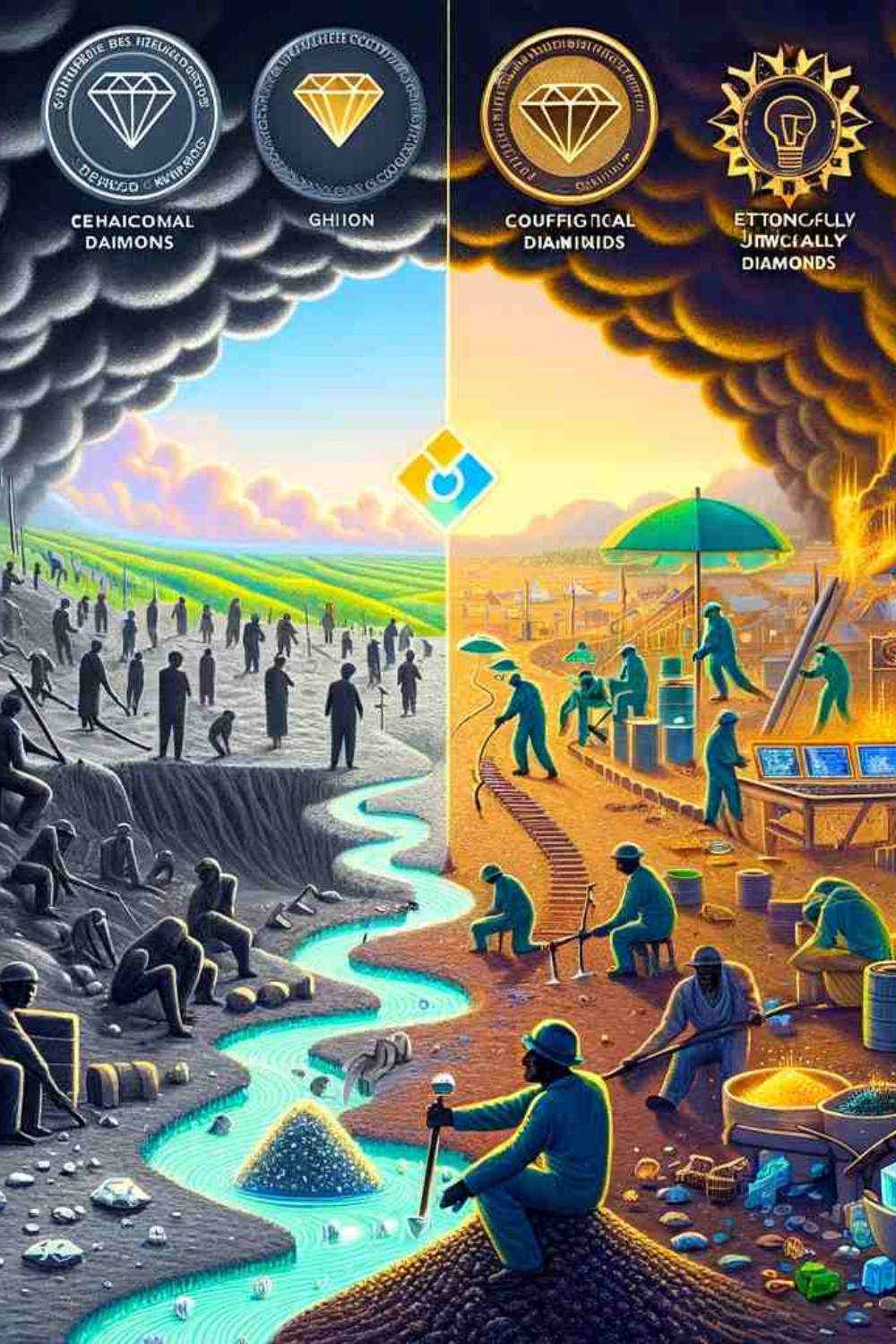Article Contents
- 1 The Challenge of Ethical Sourcing in the Diamond Industry
- 2 The Role of Certification Organizations: RJC, WDC, and KPCS
- 3 Scrutiny of the Diamond Industry: Addressing Ethical Concerns
- 4 Consumer Confidence and Certified Diamonds
- 5 Advancements in Sustainable Mining Technologies
- 6 Ethical Considerations in Diamond Extraction
- 7 The Path to Ethically Sourced Natural Diamonds: Guidelines and Certifications
The Challenge of Ethical Sourcing in the Diamond Industry
The diamond industry faces the intricate challenge of ethically sourced natural diamonds, a task that intertwines with global commerce and human rights. The allure of these gems continues to captivate audiences all over the world, underscoring the need to address their frequently hazy journey from mine to market—a journey historically marred by conflict and exploitation. Efforts to promote transparency and sustainability within the industry have become crucial, as consumers increasingly demand accountability for the origins of their cherished gemstones. Initiatives like blockchain tracking and fair trade practices aim to ensure that the process aligns with ethical standards, fostering a sense of integrity in the marketplace. After all, pairing good karma and diamonds creates a powerful narrative where beauty truly reflects responsibility and positive impact.
Efforts like the Kimberley Process have aimed to illuminate this path, providing assurances of integrity to consumers and stakeholders. However, the true effectiveness of these measures in transforming the sector is still debated.
We encounter numerous ethical considerations as we examine supply chain certifications and the environmental impact of mining practices. These issues require careful navigation to discern the true cost of splendour—a cost measured not just in carats but in human dignity and environmental sustainability.
The Role of Certification Organizations: RJC, WDC, and KPCS
Standards and certifications set by organizations like the Responsible Jewellery Council (RJC) and the World Diamond Council (WDC) ensure the ethical sourcing of natural diamonds. The Kimberley Process Certification Scheme (KPCS) is crucial in preventing conflict diamonds trade and maintaining supply chain integrity. Eco-friendly mining practices help reduce the industry’s environmental footprint and prioritize ecosystem rehabilitation after extraction. Ethical sourcing benefits the environment, supports human rights, boosts consumer confidence, and contributes to the stability and peace of diamond-producing communities.
Scrutiny of the Diamond Industry: Addressing Ethical Concerns
Understanding ethical sourcing involves analyzing the mechanisms and standards established by organizations like the RJC and WDC. These organizations form the backbone of a system designed to uphold integrity throughout the diamond supply chain, from extraction to retail.
The Kimberley Process Certification Scheme (KPCS) is critical in this architecture. Established under the United Nations and World Trade Organization, the KPCS aims to stop the flow of conflict diamonds and certify their ethical provenance. Its rigorous certification requirements foster a market where consumers can be assured of their purchases’ ethical origins.
Through responsible mining practices, companies within the RJC and WDC demonstrate their commitment to minimizing environmental degradation while ensuring fair economic benefits among workers and local communities. Compliance with these ethical standards is a moral imperative and a strategic advantage in an industry increasingly scrutinized for its social and ecological footprint.
Consumer Confidence and Certified Diamonds
Certified diamonds offer a tangible assurance of ethical sourcing through comprehensive traceability from mine to market. This traceability verifies to consumers that their purchases are conflict-free and adhere to the highest ethical standards. The process certification scheme, such as the KPCS, plays a crucial role in this assurance, though its effectiveness is often debated.
The adoption of blockchain technology further enhances traceability in the diamond supply chain. This innovation offers a secure, immutable ledger, ensuring each step in a diamond’s journey is recorded and tamper-proof. Such technological advancements are transforming the certification landscape, providing a level of previously unattainable transparency.
Certified diamonds, evaluated by third-party organizations like the GIA, IGI, or HRD Antwerp, come with a guarantee of quality and ethical sourcing. These certifications are the cornerstone of consumer confidence, ensuring that ethical sourcing extends beyond mere claims and delivers real impact by supporting peaceful, stable communities and promoting environmental conservation.
Advancements in Sustainable Mining Technologies
Eco-friendly diamond mining prioritizes implementing sustainable practices to mitigate the industry’s environmental footprint and support local communities’ well-being. By adhering to strict environmental standards, mining operations can significantly reduce their ecological impact. This involves meticulous planning and management in open-pit, underground, and alluvial mining, where diamonds are extracted from riverbeds and coastal areas.
Leading mining companies with state-of-the-art technology are at the forefront of this transition, implementing measures encompassing renewable energy sources, water conservation through recycling systems, and ecosystem rehabilitation post-extraction. For instance, energy-efficient machinery and electric vehicles are increasingly being used to decrease greenhouse gas emissions.
Moreover, responsible land reclamation ensures that mined areas are restored to their natural state, often transforming them into habitable ecosystems or agricultural land. Through such initiatives, eco-friendly diamond mining aligns with global environmental goals. It contributes to the industry’s long-term sustainability, fostering a legacy of stewardship and respect for nature and society.
Ethical Considerations in Diamond Extraction
Understanding the human cost of diamonds necessitates a deep dive into the ethical challenges and social implications behind their extraction and trade. Diamonds symbolize wealth and luxury but have a darker facet, where human rights abuses and severe working conditions are common. In regions fraught with conflict, the quest for these precious stones has financed wars and perpetuated cycles of violence.
The Kimberley Process Certification Scheme (KPCS) emerged as a pivotal measure to ensure conflict-free certification, aiming to eliminate ‘blood diamonds’ flow and certify these gems’ ethical provenance.
Despite these measures, investigation reveals that child labour and other problems still plague the diamond mining industry. The allure of diamonds conceals the suffering of those who mine them, often for meagre wages and in hazardous conditions. Ethical diamond sourcing is not merely a commercial choice but a moral imperative. It calls for stringent certifications that go beyond conflict-free, encompassing human rights and labor conditions.
True ethical diamond sourcing is thus a commitment to transparency and traceability, ensuring that every diamond purchased has not only avoided financing conflict but also supported fair working conditions and contributed positively to mining communities’ socioeconomic fabric.
Identifying ethically sourced diamonds requires consumers and jewellers alike to seek out and verify certifications that attest to responsible mining and labour practices. These certifications serve as a cornerstone in ethical sourcing, providing a transparent narrative from origin to final sale. The Kimberley Process Certification Scheme (KPCS) plays a pivotal role in this verification, ensuring that diamonds are conflict-free and originate from countries that adhere to strict international standards. Over 80 countries participate in this initiative, reinforcing its global significance.
The Path to Ethically Sourced Natural Diamonds: Guidelines and Certifications
Moreover, additional certifications from the Responsible Jewellery Council (RJC) and the World Diamond Council (WDC) further substantiate diamonds’ ethical pedigree. The presence of certifications from reputable organizations like the Gemological Institute of America (GIA), the International Gemological Institute (IGI), or HRD Antwerp increases transparency and traceability. The adoption of blockchain technology in recent years has provided an extra layer of assurance, documenting a diamond’s ethical journey through immutable records.
Consumers are encouraged to inquire about diamonds’ provenance and understand their attributes—clarity, cut, carat weight, and colour—while ensuring their ethical sourcing. This not only supports fair labour and environmental preservation but also contributes to the stability and peace of diamond-producing communities. Furthermore, by prioritizing ethical sourcing, consumers can feel confident that their natural diamond jewellery investment is not only beautiful but also aligned with their values. Taking the time to ask questions and educate oneself about the origins of a diamond can lead to a more meaningful and impactful purchase, knowing that it has positively impacted the lives of those involved in its production. In the end, promoting ethical practices within the diamond industry fosters a sense of responsibility and integrity in the global market.
Natural diamonds can indeed be ethically sourced, adhering to stringent international standards that ensure responsible mining and trading. This involves strict compliance with measures that prevent conflict diamonds’ flow, enforce labour rights, and minimize environmental damage.
Ethical diamond sourcing encompasses gems procurement through methods that uphold social equity, environmental stewardship, and economic integrity. It involves rigorous adherence to guidelines that preclude conflict diamonds, enhance supply chain transparency, and promote labour rights.
GIA-certified diamonds are typically sourced following stringent industry standards. These certifications ensure that procurement adheres to established ethical guidelines, including avoiding conflict diamonds, enforcing labour rights, and adhering to environmental regulations. Consumers seeking assurance of such ethical considerations are advised to inquire about a diamond’s certification and the jeweller’s commitment to sourcing responsibly.
The extraction of diamonds raises several ethical concerns, including labour exploitation, environmental degradation, and funding conflicts. Workers in some diamond mines may face hazardous conditions and insufficient wages. The mining process itself can result in extensive ecological damage, disrupting habitats and polluting water sources. Furthermore, diamond sales have been linked to financing armed conflicts, undermining peace and security in affected regions. Addressing these issues is critical for responsible diamond procurement. Additionally, the complex nature of the diamond supply chain presents challenges for ensuring ethical practices at every stage, from extraction to manufacturing to retail. Without adequate monitoring and transparency, it can be difficult to trace the origins of each diamond and confirm that it was sourced and processed ethically. Tackling these supply chain challenges is essential for promoting accountability and integrity in the diamond industry.
The juxtaposition of ethical sourcing against traditional procurement underscores the industry’s paradigm shift towards responsibility. The Kimberley Process, rigorous certification, and traceability promote transparency, while eco-friendly practices reduce environmental degradation.



